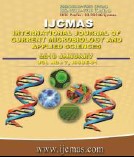


 National Academy of Agricultural Sciences (NAAS)
National Academy of Agricultural Sciences (NAAS)

|
PRINT ISSN : 2319-7692
Online ISSN : 2319-7706 Issues : 12 per year Publisher : Excellent Publishers Email : editorijcmas@gmail.com / submit@ijcmas.com Editor-in-chief: Dr.M.Prakash Index Copernicus ICV 2018: 95.39 NAAS RATING 2020: 5.38 |
Since many years malaria is a scourge of mankind. According to the report, there were 212 million new cases and 429 000 malaria deaths worldwide in 2015. India contributes 70% of malaria cases in the South-East Asia region. This study was conducted as there were only a few studies available in central part of Rajasthan. The main objective is to study the demographic profile of malaria cases and to have a diagnostic vision on them. This was a laboratory based observational, descriptive and retrospective type of study, conducted in Jawahar Lal Nehru Medical College, Ajmer. The data was collected from 1 April2016 to 31 march2017. Statistical analysis was performed with the SPSS, Trial version 23 for Windows statistical software package (SPSS inc., Chicago, il, USA) and Primer. A total 27,455patients were tested by rapid diagnostic method and 3810 slides were examined. Out of which 502 and 79 were positive for malaria, respectively. A total of 530 malaria positive cases, 59.32% were male and 40.67% were female. Maximum number were found in age group 21 to 30 years and <10 years which was 23.77%. and 22.08%. A total number of cases were highest in September (22.64%). In RDT out of 502 positive cases, P. vivax and P. falciparum were 54.91% and 39.81% were as in slide test. Out of 79 cases 79.74%, 17.72% and 2.53% were P. vivax, P. falciparum and both respectively. Early diagnosis and control activities well ahead of the monsoon season should target more to the communities with lower socio-economic status and the young age groups.
 |
 |
 |
 |
 |